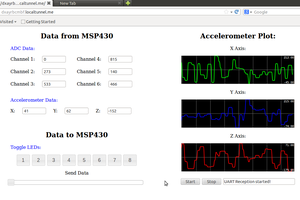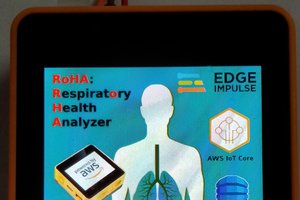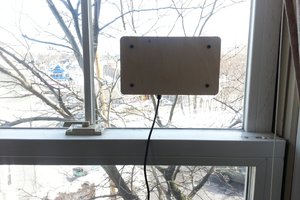Technical details
The Virtual Forest project combines a Rico Theta 360 camera and a raspberry pi with a custom outdoor housing into a rugged 360 (outdoor) time-lapse camera. The housing is made of cheap standard PVC fittings, sitting on top of a garden fence post. The optics are covered by a glass lamp shade to provide optimal transmission and limited deformation (acrylic globes can be used as well). The camera is mounted in a custom 3D printed PLA setup. Black PLA is used to limit internal reflections during dusk and dawn of any status lights. Constructed and placed in the forest the camera looks like a garden lamp (see figure).
An ethernet cable, which runs to a nearby powered hub, serves as the internet and power connection. The setup has a ground wire for surge protection due to voltage spikes from any nearby lightning strikes over the long wire run.
Data is acquired by a simple cron job on a raspberry pi, and uploaded to a cloud provider (various protocols can be used but I rely on RClone to support most available data services). Currently images are taken every half hour, which is plenty due to the relatively slow varying nature of vegetation growth.
The most recent image is visualized on a simple website using a VR A-frame setup for immersive interactive viewing.
Multiple use cases
The Virtual Forest project grew out of a personal interest in using off-the-shelve consumer hardware with interesting properties (360 field of view) within the context of scientific outreach and data acquisition. The data can be used to present a unique (VR) perspective to changes in the forest. For example, the light environment has an important function in the understory of the forest, but it is hard to visualize how this might change over the course of a day. Using data from the project a 360 video can illustrate this process, and provide ways to digitally explore the forest environment. Other visualizations include scrolling through a whole year using for example Panomoments.
More so, being involved in the US based PhenoCam network for my research I knew the strength of simple cameras as powerful (visual) tools to assess the state and model vegetation development [1 - 2] and health [3]. Aside from the very visual scientific outreach component the project serves research efforts into seasonal monitoring of vegetation growth and health. Curated data is released from time to time and deposited in permanent storage location (i.e. Zenodo.org). The latest release contains curated data for the year 2017 at Harvard forest [4]. Additional data releases are foreseen, but priority is given at MSc and PhD students using the most recent data in their research.
Useful links
Project repository (installation instructions, software, hardware)
- https://github.com/bluegreen-labs/photosphere
Ricoh Theta 360 camera lineup
Media coverage
- https://www.raspberrypi.com/news/virtual-forest/
- https://www.vice.com/en/article/bmvpq8/virtual-forest
References
1. Hufkens, K., Melaas, E. K., Mann, M. L., Foster, T., Ceballos, F., Robles, M. and Kramer, B. 2019. Monitoring crop phenology using a smartphone based near-surface remote sensing approach. – Agricultural and Forest Meteorology 265: 327–337.
2. Hufkens, K., Keenan, T. F., Flanagan, L. B., Scott, R. L., Bernacchi, C. J., Joo, E., Brunsell, N. A., Verfaillie, J. and Richardson, A. D. 2016. Productivity of North American grasslands is increased under future climate scenarios despite rising aridity. – Nature Climate Change <https://doi.org/10.1038/nclimate2942>.
3. Hufkens, K., Friedl, M. A., Keenan, T. F., Sonnentag, O., Bailey, A., O’Keefe, J. and Richardson, A. D. 2012. Ecological impacts of a widespread frost event following early spring leaf-out. – Global Change Biology 18: 2365–2377.
4. Hufkens, Koen. (2021). Spherical forest phenology images - 2017 - Harvard Forest (v1.0) [Data set]. Zenodo. https://doi.org/10.5281/zenodo.4899637
 Koen Hufkens
Koen Hufkens
 Jaspreet Singh
Jaspreet Singh
 timothy.malche
timothy.malche
